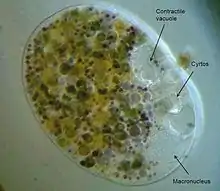Nassophorea
The Nassophorea are a class of ciliates.[1] Members are free-living, usually in freshwater but also in marine and soil environments. The mouth is anterior ventral and leads to a curved cytopharynx supported by a prominent palisade of rods or nematodesmata, forming a structure called a cyrtos or nasse, typical of this and a few other classes. When present, extrusomes take the form of fibrous trichocysts. Cilia are usually monokinetids, but vary from order to order.
| Nassophorea | |
|---|---|
 | |
| Nassula sp. | |
| Scientific classification | |
| Kingdom: | Chromista |
| Subkingdom: | Harosa |
| Infrakingdom: | Halvaria |
| Superphylum: | Alveolata |
| Phylum: | Ciliophora |
| Subphylum: | Intramacronucleata |
| Class: | Nassophorea Small & Lynn 1981 |
| Typical orders | |
|
Synhymeniida | |
The Synhymeniida and Nassulida have mostly uniform cilia arising from monokinetids. Among the former, and a few members of the latter, there is a series of small polykinetids running from below the mouth to the left side of the body and sometimes almost circling the cell, called a frange or synhymenium. Other forms only have three oral membranelles, sometimes extending out of the oral cavity, with or without a paroral membrane. These are usually medium in size, sometimes larger, and cylinder shaped.
The Microthoracida typically have three or more oral membranelles, with at least a vestige of the paroral membrane occurring during cell division. The body cilia are sparse, and often arise from dikinetids, with cirrus-like polykinetids occurring in the marine genus Discotricha. These are usually small and ellipsoid or crescent shaped, with the right side of the body curved outward, and generally have a rigid pellicle.
As first defined by Eugene Small and Denis Lynn in 1981, the Nassophorea also included the peniculids and, in a separate subclass, the hypotrichs. More recent schemes restore these to their earlier positions, leaving this group a relatively small collection of less well-known forms.
References
- Margulis, Lynn; Chapman, Michael J. (2009). Kingdoms and Domains: An Illustrated Guide to the Phyla of Life on Earth. Academic Press. p. 601. ISBN 9780080920146. Retrieved 20 January 2018.